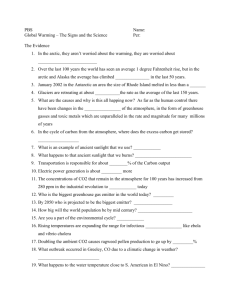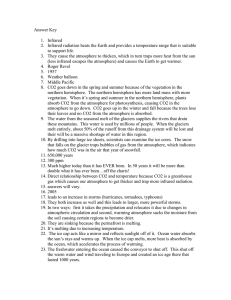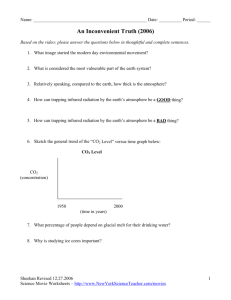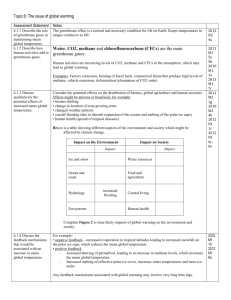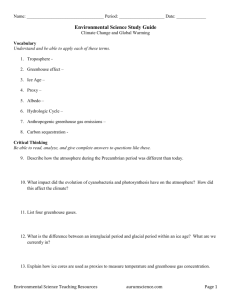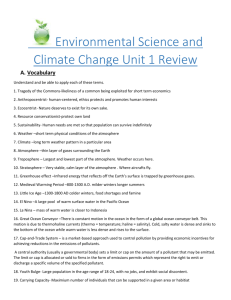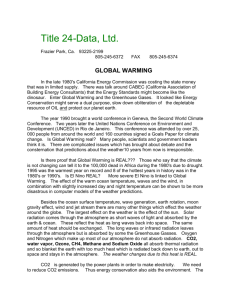Chapter 20 outline
advertisement
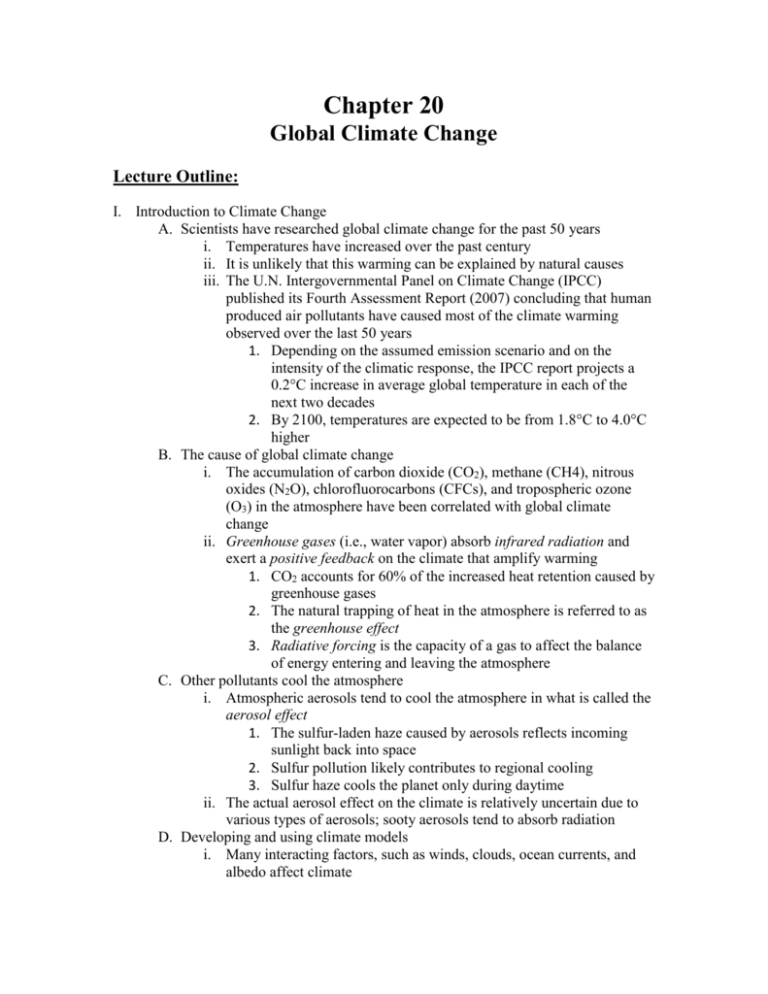
Chapter 20 Global Climate Change Lecture Outline: I. Introduction to Climate Change A. Scientists have researched global climate change for the past 50 years i. Temperatures have increased over the past century ii. It is unlikely that this warming can be explained by natural causes iii. The U.N. Intergovernmental Panel on Climate Change (IPCC) published its Fourth Assessment Report (2007) concluding that human produced air pollutants have caused most of the climate warming observed over the last 50 years 1. Depending on the assumed emission scenario and on the intensity of the climatic response, the IPCC report projects a 0.2°C increase in average global temperature in each of the next two decades 2. By 2100, temperatures are expected to be from 1.8°C to 4.0°C higher B. The cause of global climate change i. The accumulation of carbon dioxide (CO2), methane (CH4), nitrous oxides (N2O), chlorofluorocarbons (CFCs), and tropospheric ozone (O3) in the atmosphere have been correlated with global climate change ii. Greenhouse gases (i.e., water vapor) absorb infrared radiation and exert a positive feedback on the climate that amplify warming 1. CO2 accounts for 60% of the increased heat retention caused by greenhouse gases 2. The natural trapping of heat in the atmosphere is referred to as the greenhouse effect 3. Radiative forcing is the capacity of a gas to affect the balance of energy entering and leaving the atmosphere C. Other pollutants cool the atmosphere i. Atmospheric aerosols tend to cool the atmosphere in what is called the aerosol effect 1. The sulfur-laden haze caused by aerosols reflects incoming sunlight back into space 2. Sulfur pollution likely contributes to regional cooling 3. Sulfur haze cools the planet only during daytime ii. The actual aerosol effect on the climate is relatively uncertain due to various types of aerosols; sooty aerosols tend to absorb radiation D. Developing and using climate models i. Many interacting factors, such as winds, clouds, ocean currents, and albedo affect climate ii. Scientists develop simulation models to test how the Earth system works 1. A climate model is only as good as its representation of the physical laws and processes 2. Limitations include representation of clouds and changes that are likely to occur as the climate changes a. Low-lying clouds could act as a negative feedback and decrease the amount of warming b. High, thin cirrus clouds could intensify warming E. Unpredictable and extreme climate change II. The Effects of Global Climate Change A. As more and more CO2 is absorbed by the ocean, ocean water chemistry will become more acidic B. Melting ice and rising sea levels i. During the 20th century sea level rose about 0.2 m due to thermal expansion ii. A 20 year study demonstrates that the area of ice-covered ocean in the Arctic has decreased 1. The arctic ice pack is thinning rapidly, losing 40% of its volume in less than three decades 2. Melting ice has a positive feedback on global heating iii. Mountain glaciers are melting at accelerating rates iv. Greenland is losing about 44 km3 of ice each year, up from estimates of 8.3 km3 in the period 1993-1998 v. The largest potential source of ice loss is the Antarctic Ice sheet C. Changes in precipitation patterns i. Computer models indicate, as global climate change occurs, precipitation patterns will change causing various problems in different geographic areas 1. More frequent droughts 2. Heavier snow and rainstorms 3. More frequent flooding ii. Changes in precipitation patterns are likely to affect the availability and quality of fresh water in many locations iii. The frequency and intensity of storms over warm surface waters will likely increase D. Effects on organisms i. An increasing number of studies report measurable changes in the biology of plant and animal species as a result of climate warming 1. Earlier flowering times for plants 2. Earlier migrations of aquatic species 3. Shifting of geographic ranges 4. Dramatic reduction in the abundance of oceanic zooplankton, and subsequent disruption of food webs ii. Many species may become extinct due to their inability to adapt to global climate change, especially species that occupy polar seas, coral reefs, mountain ecosystems, coastal wetlands, and tundra iii. Plants will be severely impacted by global climate change due to the fact that they cannot move about when environmental conditions change E. Effect on human health i. Most of the health effects associated with climate change are indirect and have multiple, interrelated causes ii. Heat waves can cause an increased number of heat-related illnesses and deaths, particularly in the elderly F. Effects on agriculture i. Agricultural productivity is likely to go up due to increased CO2 levels ii. Certain agricultural pests and disease-causing organisms will probably proliferate and reduce yields iii. Frequency and duration of droughts may increase iv. Soil moisture may decrease v. Changes in agriculture will be geographically and demographically uneven G. International implications of global climate change i. Dealing with global climate change is complicated by social, economic, and political factors that vary from one country to another ii. Highly developed versus developing nations 1. Because developing countries have less technical expertise and fewer economic resources, they are less likely to be able to respond to the challenges of global climate change 2. Currently highly developed countries produce about ten times more CO2 emissions per person than developing countries 3. The booming economic growth and greater population in developing countries threaten to overwhelm the world with CO2 emissions as they become industrialized H. Links among global climate change, ozone depletion, and acid deposition i. Researchers have begun to study the interactions of environmental problems simultaneously ii. Environmental studies often examine only single issues III. Dealing with global climate change A. CO2 emissions produced today will still be around in the 22nd century and beyond B. To avoid the most dangerous consequences of climate change, many studies indicate that the atmospheric CO2 concentration needs to be stabilized at 550 ppm C. There are two basic ways to attempt to manage global climate change i. Mitigation ii. Adaptation D. Carbon capture and storage i. Carbon sequestration would help to slow the growth in carbon emissions ii. Carbon management is a new, unproven technology; its costs and potential ecological effects will have to be studies fully before it is adopted on a large scale iii. Sequestering carbon in trees 1. Removes atmospheric CO2 from the air by planting and maintaining forests 2. It is estimated that trees can remove 10 to 15% of the excess CO2 in the atmosphere, but would only provide a short term benefit E. Adaptation to global climate change i. People living in coastal areas could be moved inland ii. Dikes and levees could be constructed to protect coastal land iii. Crops could be substituted for those more adapted to warmer climates F. International efforts to reduce greenhouse gas emissions i. At least 174 nations have now signed the U.N. Framework Convention on Climate Change developed at the 1992 Earth Summit; its goal is to stabilize greenhouse gas concentrations ii. George W. Bush withdrew the U.S. commitment to the Kyoto Protocol in 2001 on the grounds that its implementation via a tax or permit system aimed at reducing greenhouse gases would create an unacceptable economic burden for the nation


